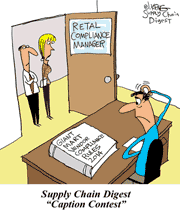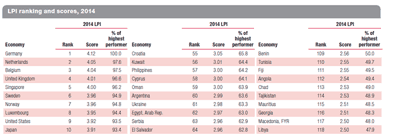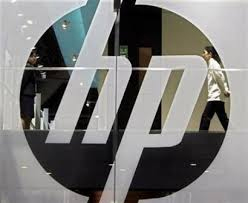 |
May 15, 2014 - Supply Chain Flagship Newsletter |
 |
| THIS WEEK'S SPONSOR: GENPACT |
 |
|
 |
|
||||||||||||||||||||||||||||||||||||||||||||||||||||||||||||||||||||||||||||
Logistics Infrastructure and the US Place in the World
|
|||||||||||||||||||||||||||||||||||||||||||||||||||||||||||||||||||||||||||||
| GILMORE SAYS: |
"In total, the US came in ninth place, the same spot it was in for the 2012 version of the report." WHAT DO YOU SAY? |
As just one local anecdote not far from me, the aging Brent Spence Bridge that carries traffic between Cincinnati and Northern Kentucky badly needs replaced, both in terms of its condition and capacity. There have been talks and semi-initiatives around replacing it for many years. The current cost estimate: $2.5 billion. There is no real notion of where that money will come from. Locals keep hoping for funding manna from Washington that so far simply hasn't arrived. There are talks of tolls, but such fees are strongly opposed by some factions. Some optimists think once an agreement and plan is reached a new bridge can be built in three years. If we see a new one in a decade I will be surprised. China just builds what it needs, with our money.
At the recent NASSTRAC conference, Peter Rogoff, undersecretary of transportation policy at the US Dept. of Transportation, said the Census Bureau estimates that by 2050 the US will have another 100 million people - most of them drivers too- and that that will create 8 billion more tons of freight that needs to be moved annually. I am not an alarmist about this by any means, but it does seem that congestion pain - and thus logistics costs - is going to get a lot worse before it gets better.
The current highway trust fund is not far from insolvency. The current funding from the surface transportation bill will likely be extended in one way or another so that the federal checks for infrastructure don't stop coming, but it's not at all clear what even a mid-term answer will be.
The MAPI-21 legislation in 2012 funded infrastructure at about $105 billion for each of two years - significantly above the level of funds brought in by gas and diesel taxes, with the difference taken from general funds. MAP-21's reign is over in late summer, and it needs to be replaced. The Obama administration is proposing a four-year, $302 billion plan that if my math is right would actually be less funding on an annual basis than we had under MAP-21, but in theory it would not require tapping into general funds.
How? Out of the $302 billion in total funding, $152 billion would come from existing gas/diesel taxes. The other $150 billion would come from one-time windfalls from Obama's plans for corporate tax reform, such as taxes on money repatriated by US companies from overseas.
This is not going to happen. The views between Democrats and Republicans on what corporate tax reform should look like are too disparate to reconcile any time soon, especially in an election year. Something else will emerge to replace MAP-21 - and in fact one Senate committee this wee approved a basic continuation of MAP-21 for six more years, plus inflation, in bi-partisan fashion.
The only problem? It would fund the highway programs at a level $100 billion above the amount being brought in by gas/diesel taxes. Will that eventually be changed to increase those taxes, which have remained the same since 1993? We'll see. That is the approach the American Trucking Associations favors, though without specifying by how much taxes should be raised.
The Obama plan also includes tolls on interstate highways, which the ATA opposes.
It makes your head hurt. And I will make the point I have made before: where is the inflection point, where the costs of improved infrastructure to carriers and shippers outweigh the benefits? I don't know, but that breakpoint is surely there on a graph someplace.
With all that as a backdrop, the World Bank earlier this year came out again with its bi-annual Logistics Performance Index.
The World Bank study primarily relies on survey data from hundreds of freight forwarders and other logistics service providers across the globe thought to have good insights into the ease and costs of moving goods into, out of, and within 160 different countries. This survey data is supplemented with input from sources operating within the countries included in the report.
The final scores are a composite across ratings for six attributes: customs, logistics infrastructure, international shipment capabilities, logistics quality and competence, track and trace capabilities, and "timeliness."
So how does the US stack up?
In total, the US came in ninth place, the same spot it was in for the 2012 version of the report. Germany earned the top spot this year, replacing Singapore, which topped the list two years ago.
The graphic below provides the rankings of all 160 countries. Seven of the top 10 countries are in Europe. Somalia finished dead last. China was number 28.
View Larger Image to See Full List
(May have to Expand Browser View)
We will have all the details of the report in our OnTarget magazine next week under the Global Supply Chain section.
So here is perhaps a surprise - the US actually ranked as number 5 on the infrastructure dimension. Its lowest score by far: international shipments, where it placed only number 26. Fix that score, and the US would have been much higher in the top 10.
That of course doesn't mean much to a truck or delivery driver stuck for hours every day in traffic.
So, I have presented a number of facts. It should be easy from here to construct (pun intended) the optimal plan.
And I now have it: drones. You know, that may really be it in the end. Logistics costs are headed up, I believe, in a big way. More on that soon.
A couple of minor corrections from last week's summary of key sessions at the JDA user conference (See Trip Report: JDA User Conference 2014 P2.)
I managed to refer to my friend Kevin Smith, ex of Kraft who gave a short but fine presentation on the Bullwhip Effect, as Fred Smith. I have just written about the FedEx CEO too many times, it appears.
The results I reported for Edwards Life Sciences use of Inventory Optimization tools were not for all inventory there but for a single SKU in a pilot. The company will go ahead with a full I/O implementation in Q3 of this year, however.
Someone at JDA sent me the name of the woman who did a great job during a presentation on managing forecast accuracy. She is Dawn Bogia from JDA's training department. Again, excellent work. All this updated in the link above. Glad people seem to be reading.
What do you think of the US' Logistics Performance Index showing? What do you think should be done about infrastructure? Let us know your thoughts at the Feedback section below.
![]()
| View Web/Printable Version of this Column |
|
|
|
YOUR FEEDBACK
We received a quite a few good letters on our First Thoughts piece on Amazon and Supply Chain Innovation a few weeks ago.
That includes our Feedback of the Week from Thom Moore of Warehouse Optimization, who says most companies believe they are more innovative than they really are. Meanwhile, Bill Alrich says he is not all that impressed with Amazon's innovation.
You'll find those good feedbacks and others letters below.
Feedback of the Week: On Amazon and Supply Chain Innovation
But I think your 50% problem comes into play: 90% of companies think that are in top 10% of innovation. Is it really innovation if there is already a 3 digit acronym for it (like TMS or WMS)? When we introduce the 90% to order optimization - a way to more fully use truck capacity - they have difficulty seeing the very real opportunity. Maybe Amazon and Supply Chain Digest will open a few eyes! Thomas A. Moore |
||
| More on On Amazon and Supply Chain Innovation | ||
Thank you for a great question. Anyone who is willing to implement a new (or innovative) approach in supply chains deserves our gratitude. Success has many fathers. Innovators innovate but without an implementer the innovation may never become real. I love what Amazon is doing. Jeff Bezos deserves a lot of credit and our gratitude for allowing Amazon's decision makers try these innovations and not be driven by greed. FYI: I have no vested relationship with Amazon. Subhash Chowdary |
||
| As always plenty to make me think a little deeper than the norm. Successful innovation is also about timing and hitting the window of opportunity at just the right time. Perhaps some collective dialogue from your readers about how to pick the right time would be useful to all of us who try to innovate whilst not losing touch with the essential basics of good practice. David MacLeod Learn Logistics Limited
|
||
As we sing their praises for supply chain innovation let's not forget the massive tax subsidy that Amazon has enjoyed for 20 years. This NBER study details it: http://papers.nber.org/tmp/51204-w20052.pdf.
I appreciate their thinking but I would still prefer to have a few locally-run stores around. I remember when the neighborhood drugstore would hold packages for pickup by their "regulars." Everything old is new again. Bill Alrich |
SUPPLY CHAIN TRIVIA ANSWER
Q: What percent of US freight volumes were moved by truck in 2013?
A: Perhaps surprisingly, just over 69%, according to the latest data from the American Trucking Associations. The ATA expects that percent to grow in coming years.
| © SupplyChainDigest™ 2003-2013. All Rights Reserved. SupplyChainDigest PO Box 714 Springboro, Ohio 45066 |
POWERED BY: XDIMENSION
|








